Table of Contents
Introduction
The post will explain how Per-Title Encoding works and the advantages of using Per-Title Encoding compared to using the same bitrate ladder for all your content. Per-Title often requires fewer ABR ladder renditions and lower bitrates that translate into storage, egress and CDN cost savings. It also improves QoE with less buffering and quality drops for viewers, along with better visual quality. On top of that, it can make 4K streaming viable, turning it from a loss leader and financial burden into a revenue generator. Keep reading to learn more.
Per-Title Encoding is key for cutting streaming costs
For the past couple of years, “controlling costs” has been among the top challenges for video streaming, according to the results of Bitmovin’s annual video developer survey. While the pandemic years created a boom for streaming services and content creation, things have now shifted toward cost-cutting in a few different ways. Several platforms have cut back their budgets for original content and are removing shows and films from their libraries to save on licensing and other operational costs.
Another trend highlighted by industry analyst Dan Rayburn, has been the lowering of bitrates, including removal of 4K streaming in some cases. Services that do still offer 4K often restrict it to their highest-priced subscription tier. Back in 2014, Dan called out the cost and QoS challenges services would face when delivering 4K video, and many are still struggling with that reality, especially those using a fixed bitrate ladder for their encoding.
Per-Title Encoding can have a huge impact on 4K content, something that can be seen in the recommended internet connection speeds for 4K streaming:
Netflix: 15 Mbps (they use their own version of per-title encoding)
Disney+: 25 Mbps
Paramount+: 25 Mbps
Max: 50+ Mbps
For long form content that gets even in the tens of thousands views, the difference between 15 Mbps and 25 or 50 Mbps will add up quickly in the form of excess network egress and CDN costs. With non-optimized encoding at those high bitrates, a viral hit that ends up getting hundreds of thousands or millions of views can end up being a financial burden. Using Per-Title Encoding ensures each video uses only the bits needed for its content and complexity and when combined with more advanced codecs like HEVC and AV1, it can make a game-changing difference. When Bitmovin added support for using Per-Title Encoding with the AV1 codec, I was shocked to see just how low the bitrate could go (often under 2 Mbps).
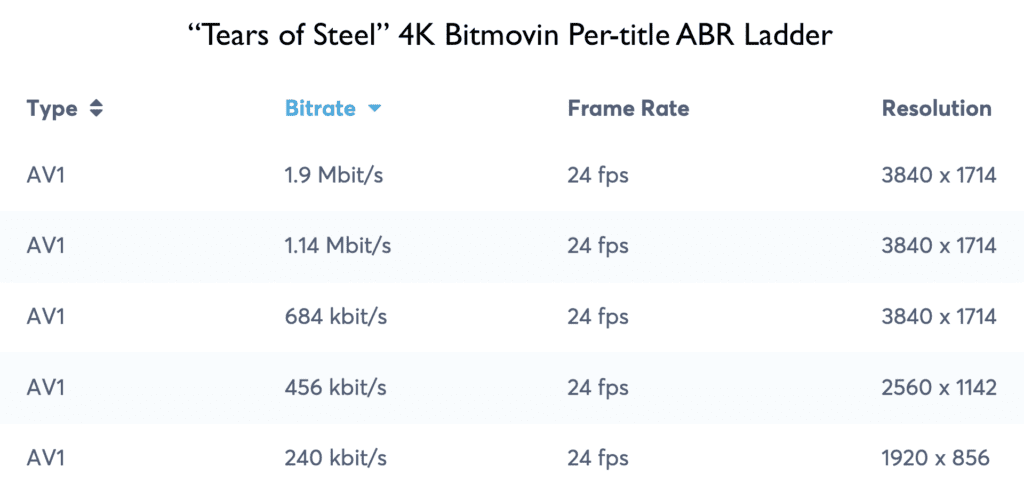
How does Per-Title Encoding work?
In 2012, Bitmovin’s co-founders published a research paper titled “Dynamic Adaptive Streaming over HTTP Dataset” that, among other things, provided data for per-genre encoding that would further evolve into Bitmovin’s Per-Title Encoding. Per-Title Encoding is an optimization of adaptive bitrate encoding that analyzes the complexity of a video file and determines the encoding settings needed to maintain the highest level of visual quality together with the most efficient adaptive bitrate ladder.
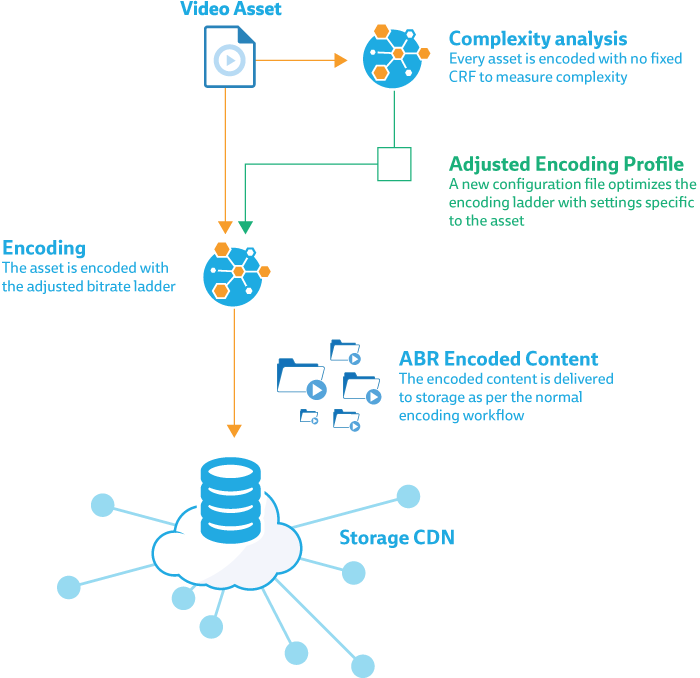
In 2015, Netflix published a tech blog that detailed their research and development of their own per-title encoding. Through brute force encoding of content at different resolutions and quality levels, they found that the ideal adaptive bitrate ladder for each video would form a smooth convex hull when plotting quality vs bitrate. When the bitrate and resolution pairs in their ABR ladder fell along the convex hull, it maximized quality for the viewer and meant that data was being distributed efficiently. Bitmovin’s Per-Title complexity analysis spares you the excessive testing and experimentation and automatically determines the ideal ABR ladder and convex hull for each file.
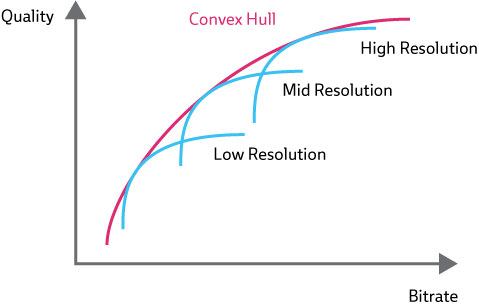
Per-Title Encoding ABR ladder vs fixed bitrate ladder
The graph below shows how Per-Title Encoding provides better QoE with lower bitrates than the competition’s static bitrate ladder for a 4K source. Per-Title Encoding matches the source at 3840x2160p, with a bitrate of 6050 kbps and a VMAF score of 95.5. The static ladder is capped at 1080p and requires 7830 kbps for a lower VMAF score of 90.9. That’s 22.7% bitrate savings with better quality by using Per-Title.
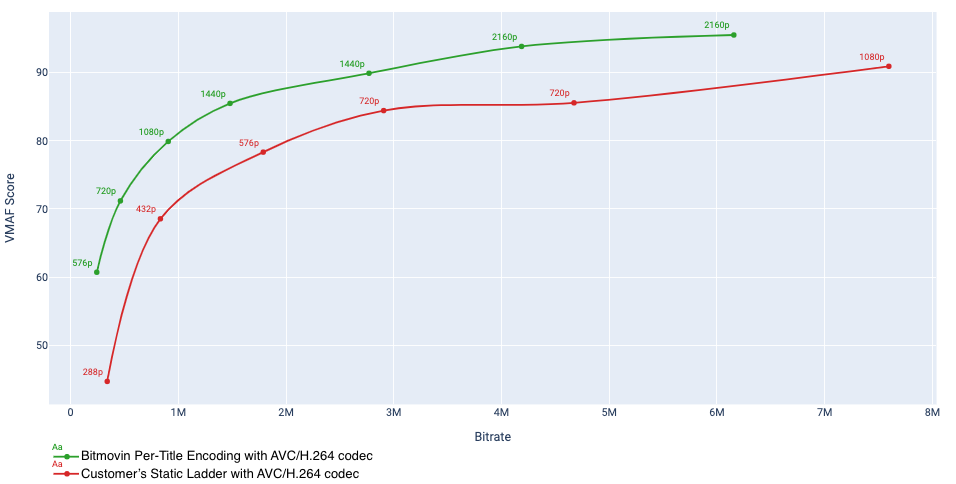
The next example uses the HEVC codec for the customer’s UHD ladder vs Bitmovin Per-Title Encoding. The highest rendition on the Per-Title ladder only needs 1.9 Mbps to hit a VMAF score of 94.9, while the static ladder uses 15 Mbps, an increase of 13.1 Mbps in bandwidth for an undetectable VMAF difference. This equates to 87% savings on the CDN bill for viewers of the top rendition, without sacrificing quality.
With a duration of 44:39, the top rendition for Per-Title would mean 0.622 GB in data transfer while the top rendition for the fixed ladder would require 5.023 GB. For popular content tens of thousands of views (or more) those savings add up quickly. At a time when some services are removing 4K renditions, these optimizations make it feasible to provide UHD and improve margins on premium subscription tiers.

Next we have some medium-complexity 1080p content where using Bitmovin Per-Title with a more advanced codec like HEVC can make a huge difference. Throughout the ladder, using Bitmovin Per-Title with H.264 provides some quality gains and bitrate savings compared to the customer’s static ladder with ffmpeg, but the results from Per-Title with HEVC highlight the impact of using a newer generation codec. HEVC delivers 1080p in the 90+ VMAF range with only 2 Mbps while ffmpeg with H.264 needs over 6.5 Mbps for the same quality. That’s around 70% bandwidth savings for viewers of the top rendition. At the lower end of the spectrum, a viewer with 1 Mbps available bandwidth would be limited to 432p with the static H.264 ladder, but would still receive 1080p with Per-Title HEVC.

Storage savings with Per-Title Encoding
Bitmovin’s Per-Title Encoding can deliver massive storage savings when compared to fixed bitrate ladders, by removing unnecessary renditions from the ABR ladder and ensuring the most efficient bitrate is used for each piece of content. The chart below shows the potential savings on your storage bill from using Per-Title Encoding over a fixed ladder with AVC encoding.
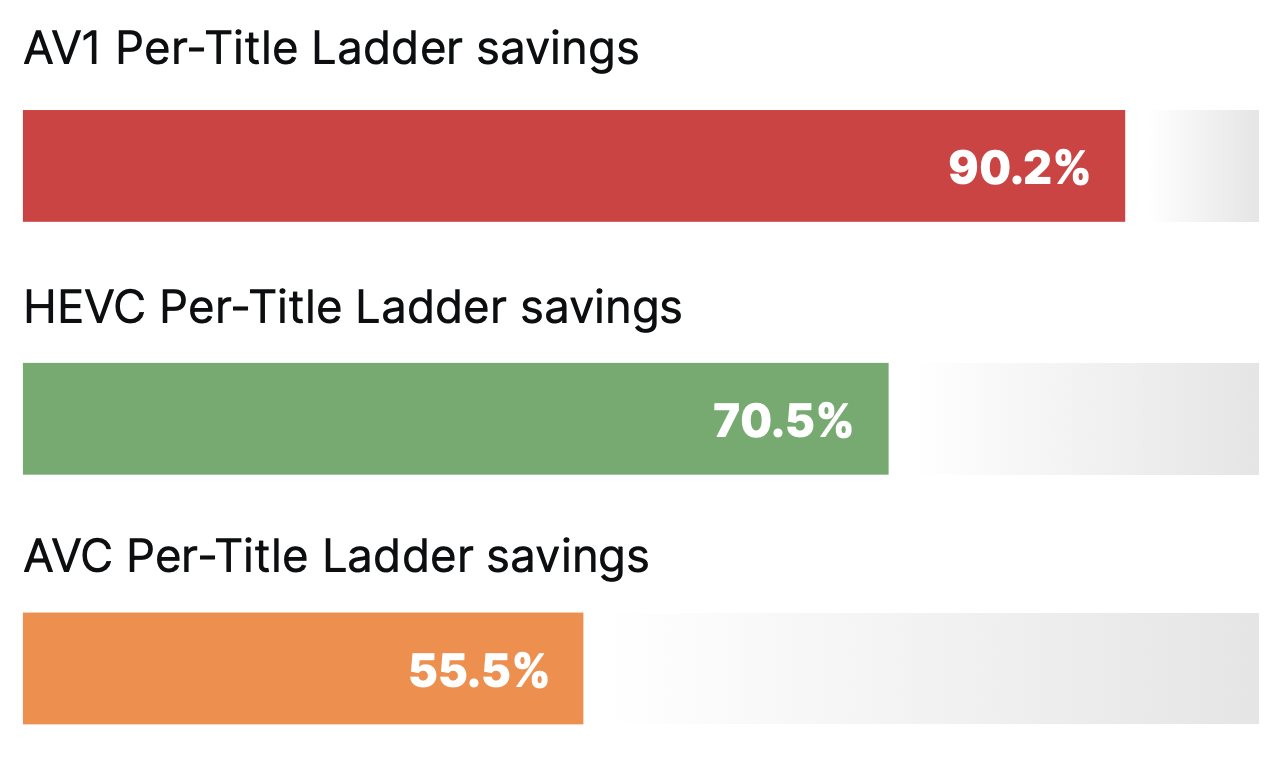
Improve quality without increasing bitrates
Per-Title Encoding can also improve quality without needing to use additional data. The chart below references our customer’s fixed ABR ladder using the AVC codec and shows the quality improvements (% VMAF score) that Bitmovin’s Per-Title provided with different codecs at the same bitrate.

Bitmovin Smart Chunking prevents lower quality outlier frames
The graphs below plot the VMAF quality scores of every frame in our customer’s sample content. Bitmovin’s smart chunking virtually eliminates all of the lower quality outlier frames that are present in our competitor’s encoding and would be noticeable by viewers. Smart Chunking is now active for all Bitmovin VOD Encoding without any additional configuration or cost to the user.

Conclusion
In the past, balancing cost and quality has always been a tradeoff, but using Per-Title Encoding may be the single most effective way for streaming services to reduce their total cost of ownership without sacrificing their viewers’ quality of experience. With consumers having an abundance of options, the QoE improvements Per-Title provides can mean the difference between renewal and churn and its cost savings can tip the scales toward profitability. With streaming firmly in a cost conscious era, using Per-Title Encoding makes more sense than ever before.
Ready to see what difference Per-Title Encoding can make with your content? Anyone can test it out for free with no coding required using our VOD encoding wizard. We also have a comparison tool in our dashboard where you can input your own content or use common test videos. Try it out today!

Related Links
Choosing the Best Per-Title Encoding Technology
What is Per-Title Encoding and how does it work




